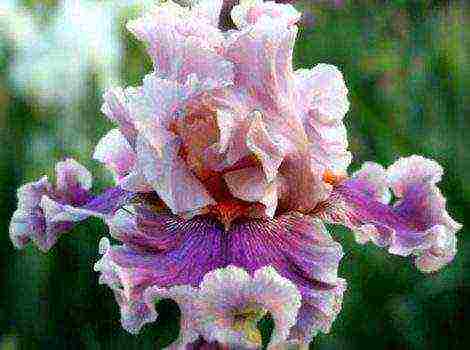Content
- 1 Types (types) and varieties of juniper
- 2 When and how to plant a juniper outdoors
- 3 Outdoor Juniper Care
- 4 What is better to plant - a juniper or a thuja?
- 5 How to properly plant a juniper in open ground
- 6 Juniper, care in the garden and in the country
- 7 Sapling planting technology
- 8 Growing juniper from seeds
- 9 How to apply fertilizers correctly
- 10 Winter care
- 11 Location on the flowerbed: 8 beautiful patterns
- 12 Types and varieties of juniper
- 13 Features of a juniper (shrub)
- 14 Juniper planting
- 15 How to care for the garden
- 16 Reproduction of juniper
- 17 Wintering juniper in the country
- 18 The main types and varieties of junipers with a photo
- 18.1 Common juniper (Juniperus communis)
- 18.2 Juniper virginiana (Juniperus virginiana), or "pencil tree"
- 18.3 Juniper horizontal or prostrate (Juniperus horizontalis)
- 18.4 Juniper Cossack (Juniperus sabina)
- 18.5 Chinese Juniper (Juniperus chinensis)
- 18.6 Rocky juniper (Juniperus scopulorum)
- 18.7 Scaly juniper (Juniperus squamata)
- 18.8 Juniper medium (Juniperus x media)
- 19 Juniper properties
Somehow, quite separately, among other evergreens in the garden, the juniper is valued, whose very presence heals many diseases. The plant, friendly to people, is one of the favorite crops that fills the air with life-giving resins and amazes with a beauty that is dear to the heart, perfectly combined with many green friends. Juniper is a rather unpretentious coniferous plant. But in order to properly plant it and take care of it, you need to know a few basic rules.

Types (types) and varieties of juniper
Among junipers, their following shapes and sizes can be distinguished:
- Tree-like;
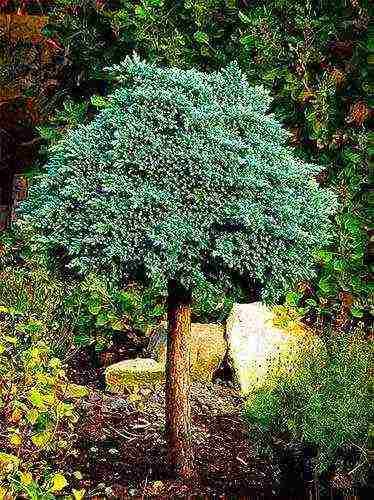
- Columnar;
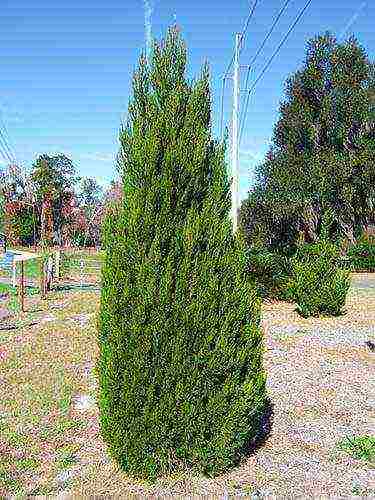 Virgin spartan
Virgin spartan - Shrubby (with spreading bushes);
 Cossack Sabina
Cossack Sabina - Low-growing (creeping, ground cover).
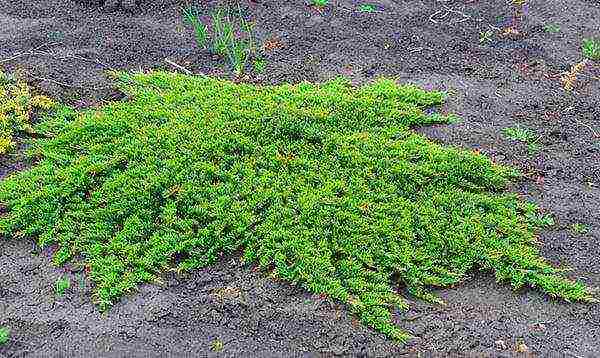 Horizontal Prince of Wales
Horizontal Prince of Wales
The most popular types and varieties of juniper are:
- Ordinary (Depressa Aurea, Meyer, Green Carpet, Horstman, Repanda, Arnold);
- Virginian or North American (Gray Oul, Skyrocket, Hetz, Glauka);
- Cossack (Variegata Blue and Gold Tamariscifolia, Rockery Jam, Glauka, Sabina);
- Horizontal or outstretched (Lime Glow, Wiltoni, Blue Chip, Prince of Wales);
- Chinese (Strickta, Kurivao Gold, Spartan, Variegata);
- Rocky (Blue Arrow, Blue Haven, Munglow);
- Scaly (Dream Joy, Blue Star, Blue Carpet).
In more detail you can get acquainted with the appearance of different junipers in the following videos or in the last paragraph “What is it better to plant - a juniper or a thuja? "
Video: types and varieties of junipers
When and how to plant a juniper outdoors
Landing dates
The main thing when planting conifers is to keep the earthen lump around the roots moist, and you can plant junipers in spring, autumn, and even summer.
Note! If you decide to plant a juniper in the summer, then the young seedling should be shaded and watered more often (but not overflowed!) Throughout the summer.
But still, the optimal time for planting junipers is spring, around April-May, when the ground warms up a little. But it is often planted in autumn in September-October.
How to choose the right seedling
A warning! Never buy seedlings from random people. As a rule, they have a bare root system, and such juniper seedlings practically do not survive.
It is better to purchase cypress seedlings in garden centers. In them, junipers are sold in special containers, in other words, their root system is closed and well-developed.

As for the age of the seedling, it is optimal to purchase 3-4 years old.
Also, when buying a seedling, you should pay special attention to the tips of the needles. They should be green and elastic (bendable). If on examination you notice that the tips are dry and breaking, then such a plant is not worth buying. It is quite obvious that it is sick or was overdried, which means that the likelihood that it will take root well is quite low.
Place in the garden
After you select and buy a seedling, you will need to find the right place to plant it in your summer cottage garden. Juniper loves sunny and well-lit places. Growing under the sun, it will acquire all its best properties. If you plant it in deep shade, the crown will begin to deform and become loose. However, such varieties as Virginia and ordinary, can grow in light partial shade.

Important! The Chinese juniper tends to burn strongly at the end of winter or in strong winds, so it is better to plant it in a quiet place, or next to taller conifers.
If you want to plant several seedlings side by side, then it is advisable to do this at a distance of 50 to 200 centimeters, depending on the size (shape and type) of the juniper seedling.
Planting pit and soil
The diameter of the planting pit for a juniper should exceed the earthen lump of the seedling by about 2-3 times, and in depth it should be about 50-70 centimeters.
Junipers do not tolerate waterlogging, therefore, a drainage layer must be laid at the bottom of the planting pit. For drainage, you can use broken bricks, stones, pebbles, rubble or gravel. Then a small layer of sand should be poured.
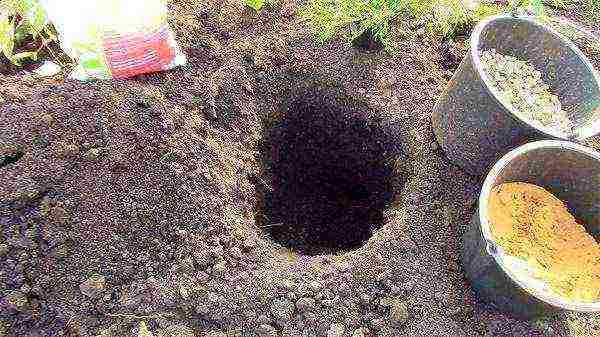
This ephedra cannot be called a plant demanding on the soil, but it is still recommended to fill the planting hole with fertile soil. For example, you can prepare this soil mixture: 2 parts of peat, 1 part of soddy clay soil and 1 part of river sand. Or this: 2 parts of sod or leafy land, 1 part of peat and 1 part of sand.
Clarification! Each variety of juniper has slightly different soil requirements. For example, if you are planting Virginiathen put more turfy clay land, if Siberian - sand, Cossack - add wood ash, dolomite fly or lime (in other words, it is necessary to reduce the level of soil acidity).
Immediate phased disembarkation
Step-by-step instructions for planting juniper in open ground:
- Choose the sunniest and well-lit place on the site.
- Dig the required planting hole and lay a drainage layer on the bottom, sprinkling it with sand.

- Prepare a soil mixture depending on the species and fill the hole, but not completely.
- Carefully remove the seedling from the container, being careful not to fall apart, and transfer to the center of the pit. The root collar should be slightly higher than the level of the pit (by 5-8 centimeters). When the earth settles down after watering, the seedling will drop to the right place.
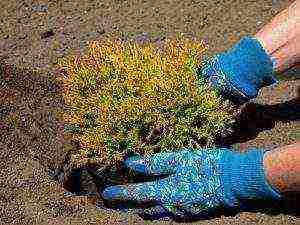
- Cover the entire space around the seedling with soil mixture and tamp it lightly with your hands so that there are no air voids.
- Thoroughly spill the trunk circle evenly from all sides.
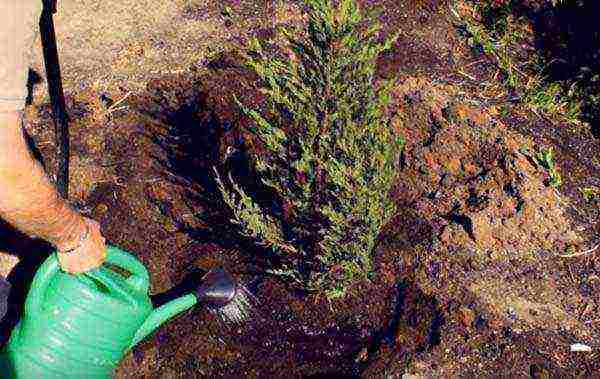
- When the moisture is absorbed, the earth will sag a little, it will be necessary to fill it up.
- Mulch the trunk circle to trap the rapid evaporation of moisture.For mulch, you can take peat, wood or pine chips (bark), sawdust, or even dry leaves. The mulch layer should be about 5-10 centimeters.
Video: planting and caring for a juniper
Outdoor Juniper Care
To preserve the beauty of this ephedra, so that the crown of this tree is fluffy and dense, and the color remains throughout the season, the juniper must be properly looked after.
Newly planted seedlings need plenty of moisture and should be watered at least once a week.
Adults and well established plants watering practically unnecessary. Unless the summer is hot and dry, then 2-3 times per season it is still worth watering, pouring 1-3 buckets at a time, depending on the size of the bush.
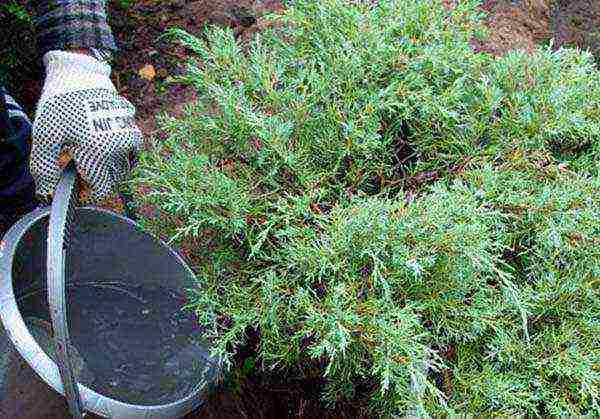
Remember! Juniper does not tolerate dry air very well, so it will respond well to periodic spraying with water, sprinkler irrigation.
Juniper not required frequent and abundant feeding, especially since he does not need organic matter. Except that young plants should be fed in the spring - in the month of April and May. Take 30-40 grams of nitroammophoska, potassium nitrate or other complex mineral fertilizer similar in composition and scatter it around the trunk circle, and then spill it well with water.

As such pruning the juniper is not required (another matter is cutting and shaping the plant), except that in early spring you need to sanitize, in other words, cut off all dried and broken branches (although some gardeners do this and late autumn).

If you notice that some branch has deviated to the side, but is still alive, then it is not necessary to cut it off, you can simply pull it up with a string. After a certain time, it will return to its original position again.
Important! The essential oil in juniper resin is caustic, so be sure to wear heavy canvas gloves and oversleeves before pruning. Failure to do so may cause long-term irritation on the hands.
In caring for junipers, it plays a vital role. antifungal treatments... They need to be done regularly, rather than waiting for the fungus to show up. It is especially important to spray it with fungicides (for example, the Topsin-M systemic fungicide is excellent) after warm and humid weather, as well as in late autumn.
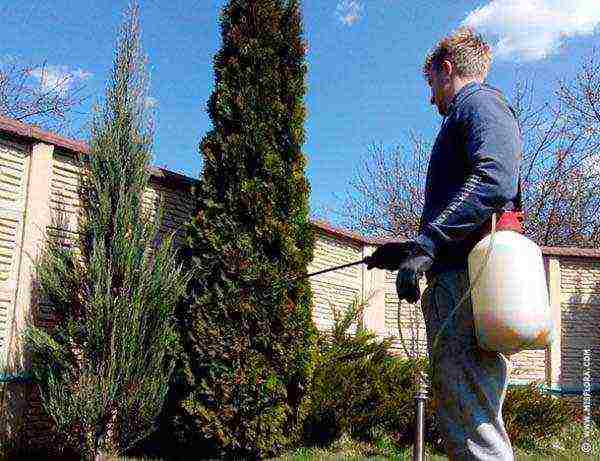
By the way! In late winter and early spring, juniper can get sunburn, in other words, it canburn out (this often happens in Siberia), so it should be shaded. For example, throwing burlap on the plant or installing screens. Only in no case not should use agrofibre, because it just transmits ultraviolet light.
Video: proper care for junipers in the open field
Important! You can find all the detailed information on preparing juniper for winter (shelter, pruning) in this material.
What is better to plant - a juniper or a thuja?
Many gardeners, when they begin to think about what kind of ephedra is better to plant on their site, cannot decide - a juniper or still a thuja. Let's try to understand the differences and advantages of planting each of them.
Both juniper and thuja belong to the same family - Cypress, so they are in many ways similar.
Pay attention! You can read detailed information about planting, growing and caring for thuja in this article.
By shape and size
For example, thuja western Columna is very similar to the Blue Arrow rocky juniper, they have equally smooth and clear high silhouettes.
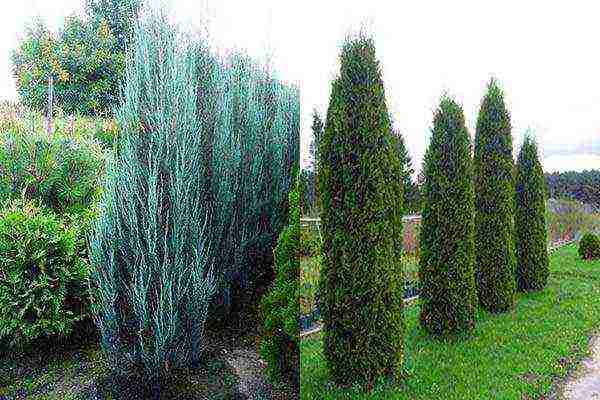
Left - Blue Arrow Juniper, right - Thuja Columna And the juniper of the Chinese Strikt, with a skillful haircut, can be made completely similar to the conical western thuja Smaragd.

Left - western thuja Smaragd, right - Chinese strickta juniper If the spherical junipers have not yet been bred, then the thuja is quite widely represented - this is Globoza, and Woodwardy, and miniature Teddies.
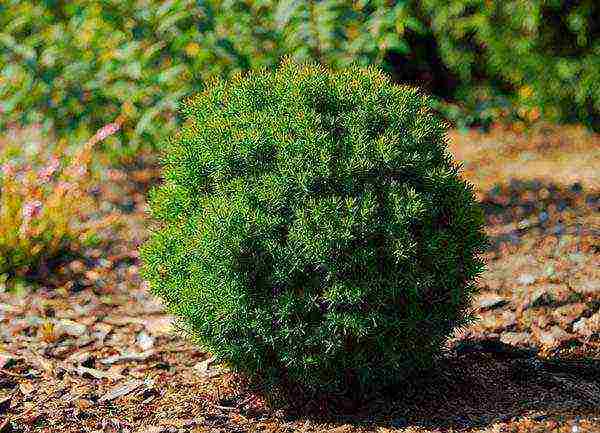 Tuya Teddy
Tuya Teddy
But junipers have a huge assortment of spreading and creeping crowns. These include the following: Cossack, Virginian Hetz, Scaly Blue Carpet.
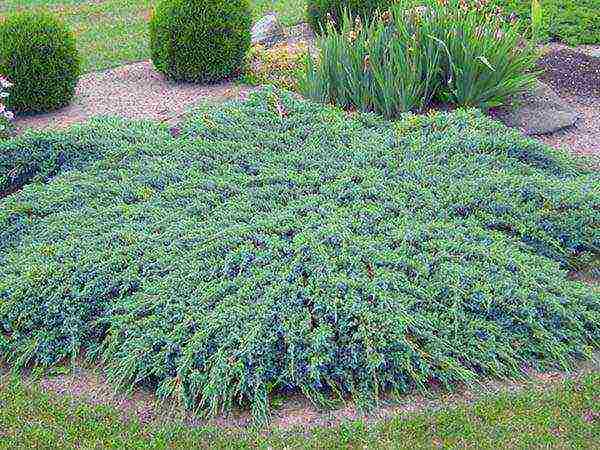 Scaly Blue Carpet
Scaly Blue Carpet
By color (color)
In addition to the natural (standard) green color, juniper and thuja today can be in fact any color: green, blue, and yellow.
For example, Tuya Miriyam is a green thuja with yellow tips.
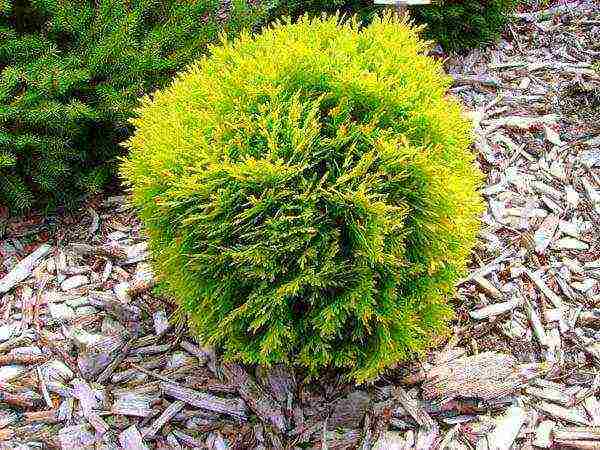
The Blue & Gold Juniper is a plant with blue and yellow tops.
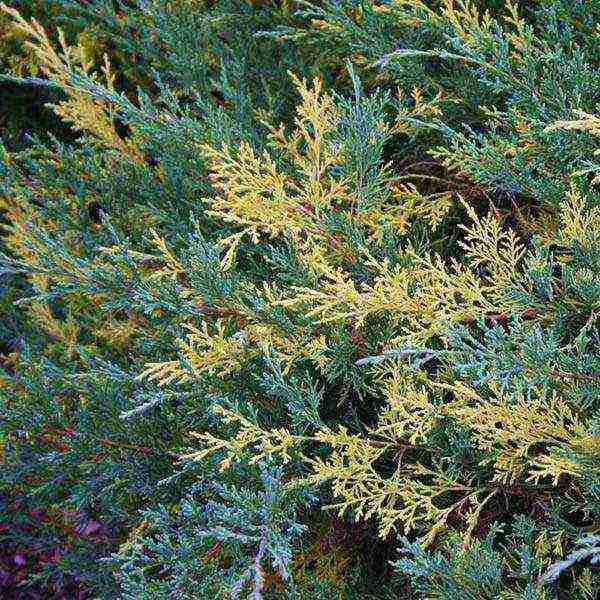
For use in landscape design
Junipers are usually planted either as single plants or in loose groups of several bushes.
The use of juniper as a hedge is rather limited: the price is high and grows very slowly, so thuja varieties such as Columna and Brabant are better suited for this.

If you need to decorate a slope on your personal plot, decorate an alpine slide or rockery, then creeping or ground cover varieties of juniper will be the best choice.
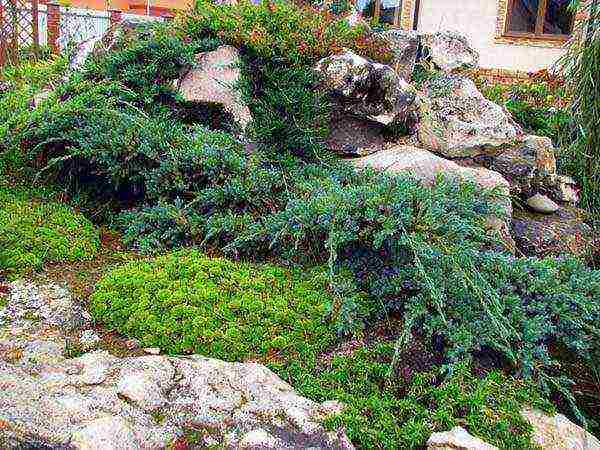
According to the conditions of growing and care
Thuja perfectly tolerates the dusty and gassed air of city streets, therefore it is very often used for landscaping large cities and industrial centers. On the contrary, junipers will suffer and waste away from dusty and gas-polluted air, therefore, as a rule, they are planted only in suburban areas.
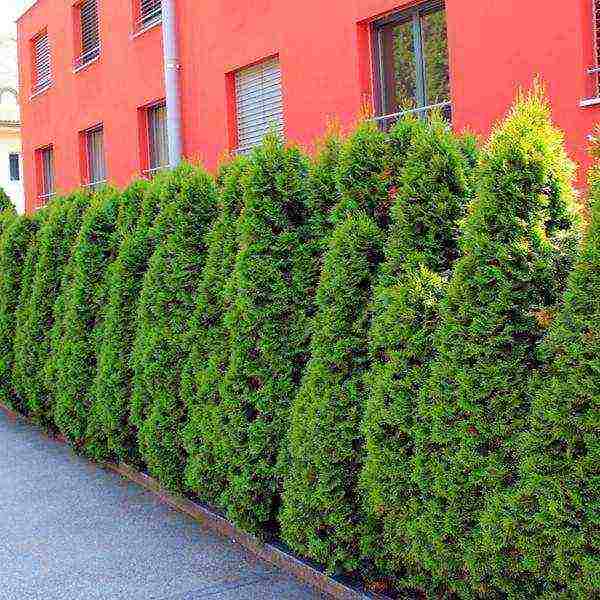
Juniper is an extremely light-loving, frost-resistant, drought-resistant and not demanding plant for soil conditions. This is due to the fact that its root system goes several meters into the soil and receives all the necessary nutrition from there.
Thuja is a moisture and light-loving plant that can grow relatively successfully in the shade, but it is noticeably more demanding on soils. If the land is infertile and poor, then for normal development the plant will need to be additionally regularly fed.
In general, both thuja and juniper are considered quite unpretentious conifers. However, young, recently planted seedlings for the winter should be insulated and covered, especially if you live in a cold climate.
By useful properties
Juniper is healthier than thuja. Because the phytoncides secreted by its needles kill almost all pathogenic microbes. Traditional medicine is often used cone-berries of juniper, which have diuretic and disinfectant properties. It is useful to chew 1 berry per day during a flu epidemic, this will significantly reduce the risk of illness. These berries are also used in cooking: they make kvass, beer and gin, use them for smoking meat (6-8 pieces per 1 kg of meat), and also make juniper brooms for a bath.
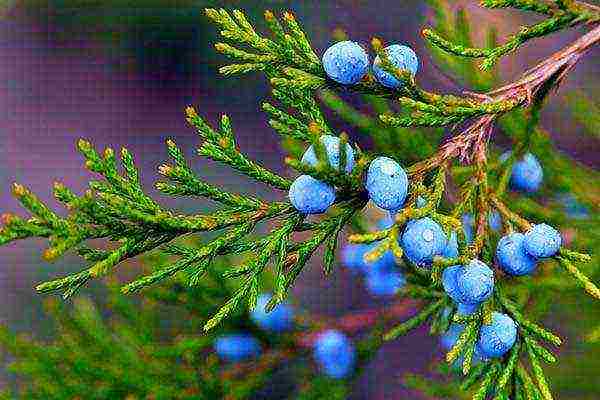
By the way! Junipers can live up to 1000 years, while thujas tend to live up to a maximum of 100 years.
Video: which is better to plant - juniper or thuja
Subject to all the rules for planting and caring for junipers in the open field, you will have this wonderful plant in your summer cottage, which will delight you with its appearance and make the atmosphere in your garden healing and wholesome.
Video: secrets of growing and features of caring for juniper
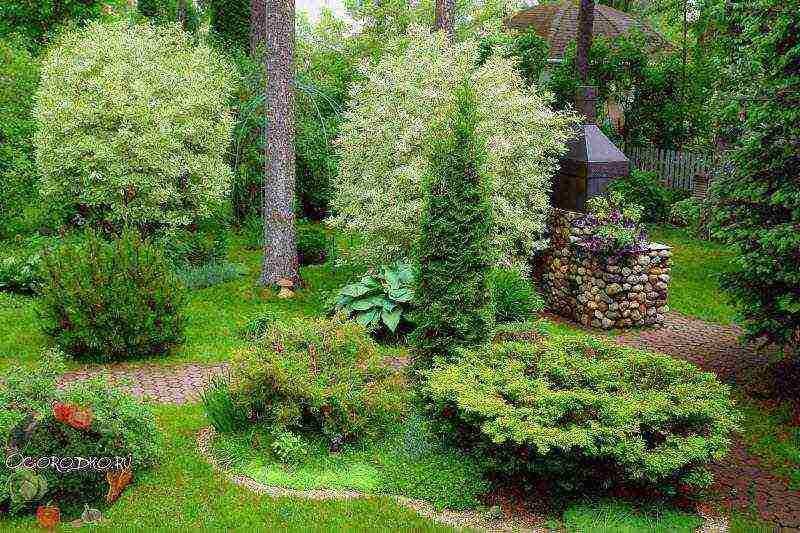
A beautiful juniper, planting and care in the open field for which is not too difficult at first glance, still require attention from the gardener in order to delight the owners with a beautiful and healthy look and, you need to know how to do it all correctly, at what time, in the fall or in the spring, how to feed the plant, how to transplant it to a new place, how to spray it against yellowing and rust, how is pruning done, etc.
How to properly plant a juniper in open ground
Planting in open ground is a laborious process with many nuances, the observance of which will allow you to enjoy a beautiful plant in the country or in the garden.
The best time for planting junipers is the beginning of spring, when the frosts have already ended, but the weather is not too warm yet. An excellent option would be the period when the snow melts. Of course, you can plant the plant later, but then there is a danger of burning out the needles. It should be said that in a later period, young growth should be planted.
Many are interested in the question of how to plant a juniper in the fall. In this case, the plant may not have time to take root, as a result it will die. It is important to note that if a juniper has a closed root system, then it can be planted at any time of the year.
When choosing a site for juniper, take care of constant sun. The sun's rays should shine on the plant all day. Only on hot summer days, some juniper varieties require shading.
How much light hits the plant depends on its appearance. If shade prevails on the site, then the plant will grow poorly. The brightly colored juniper will no longer have the original color of the needles.
As for the choice of soil, the species you choose plays an important role here. So, for the Cossack, ordinary and Central Asian varieties of juniper, soil is required, which includes dolomite flour or slaked lime.
Siberian juniper loves sandy or sandy loam soil, for Virginia - clay soil with compost is suitable.
The remaining species take root well if peat, sand, a protective layer with peat and wood chips are added to the soil to create an acidic reaction.
The plant is sold in various containers. The most suitable plant for planting is a plant in containers, with a volume of 5 liters pots with a closed root system. If you buy a seedling with an open root system, be sure to check the roots, they are white and quite strong. Do not buy a juniper if you notice damage to it.
When planning to plant large plants, then certain skills or the help of a specialist will come in handy here. These plants are pre-grown in the ground and must be dug up to be sold.
True, experts do not recommend planting grown adult plants. This is due to the fact that during growth the roots go far into the ground, when excavated, the main root is often damaged, which leads to the fact that the juniper dies after transplantation. Therefore, an adult juniper should be planted in the winter with a frozen soil ball. Disembarkation at such a time increases the chances of good survival and healthy development in the future.
Remember, before planting, be sure to moisten the lump with plenty of water, about 2 hours before planting.
Prepare the site in advance. Dig a hole in it, the size of which directly depends on the size of the plant. For example, a 1m × 1m pit with a depth of 50 cm is suitable for a young plant. Experts recommend making a pit 2 times the size of a soil ball.
At the very bottom of the pit, where it is planned to plant the plant, drainage is added, with a layer of about 20 cm (it is better to use broken brick, large pebbles and sand). The free space is filled with cultivated soil. This kind of soil is suitable for any kind.
When placing, be very careful not to damage the root system and the earthy ball. Make sure that in young plants the root collar is at the surface of the ground, and in adult specimens it rises by about 10 cm.
Then pour plenty of water. The area near the trunk is covered with a protective layer (mulch), which can be peat, pine bark, chips, sawdust, crushed cones or pine nut shells. The mulch should be 10 cm thick.
Transplanting a juniper from the forest is not very difficult, the main thing is to follow the rules:
- Only young and small plants are suitable for transplanting, because they have not yet formed a large root system
- After you choose a plant, be sure to mark the sunny side of it (so as not to get confused, before digging out), and plant it on the exact same side
- Dig up the plant along with a lump of earth, place it in a film or burlap, wrap and tie
- Plant in the same way as for a plant purchased from a nursery.
Juniper, care in the garden and in the country
Summer residents appreciate the juniper for its beauty and ease of care. By adhering to some rules of care, you can grow a healthy and beautiful plant.
A juniper goes without water for a long time, but in the summer it should be watered at least once every 30 days. As practice shows, this happens much more often, especially in hot sultry weather, you need to water the plants every day.
Sometimes it should be sprayed with plain water from a spray bottle. Spraying is best done weekly in the morning or evening, so as not to burn the green part of the bush.
In the spring, the soil is fertilized with nitroammophos in a proportion of 45 grams per 1 sq. M. In the summer, you can use organic fertilizers and mineral fertilizers, if the plants require it. Fertilize the soil if the juniper grows poorly.
As for the transplant, the juniper takes root very poorly, therefore, it is carried out only if necessary. To do this, be sure to prepare the soil - mix sand, coniferous soil and peat in equal proportions. After transplanting, pour water well.
Juniper does not require pruning, you just need to remove dry branches. If you want to create a beautiful crown, then you cannot cut off too much, the plant will get sick.
In winter, the young juniper is covered with lutrastil, the adult plant is simply tied up so that the branches do not break off under the weight of the snow. If there is a lot of snow, shake off the plant occasionally.
The onset of spring is a dangerous period, the sun can burn out the needles. To avoid this, shade the juniper with a cloth or burlap. When the snow has completely melted, the burlap can be removed. Clean the trunk circle, remove the protective layer so that there is no root rot. Dig up and loosen the ground. After the soil has dried, a new protective layer can be applied.
Now you know, dear readers, that a juniper, planting and caring for which is not difficult, can delight you with a beautiful view for many years.

- Type: conifers
- Full-bloom Period: May
- Height: 1.5-30m
- Green color
- Perennial
- Hibernates
- Shady
- Drought resistant
Unlike the southern and tropical regions, in the northern latitudes, conifers have a special place in the garden landscape - in the off-season and in winter, only they are able to revive the garden with their colors. Evergreen conifers are usually "garden soloists" due to the rich color of the needles, ranging from dark emerald to silvery gray and golden. Junipers, which have a wide range of crown shades and successfully complement the “all-season” garden, are no exception - a garden designed to be attractive at any time of the year. Planting and caring for a juniper is not an easy process - knowing the nuances allows you to grow an ephedra of high decorativeness, which fits favorably into landscape design.
Spherical, pyramidal, conical, weeping or creeping - the shape of the crown of a juniper can be any, which expands the possibilities of landscape design in the formation of compositions that are expressive in their geometry. By combining only conifers, you can compose an original garden, bright in originality and style: landscape or regular, avant-garde or classical, ethnic or modernist.
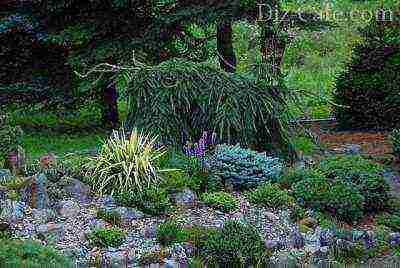
A rock garden created by combining juniper with other types of conifers will look great at any time of the year.
Coniferous plants gracefully decorate the garden, creating a calm and elegant landscape. Large cone-shaped or columnar junipers will be good in single or group planting, acting as the center of the landscape composition.A single juniper looks catchy in the form of a topiary. A single large plant is always a dominant feature in garden design, which it is desirable to surround with smaller plants.

A group planting of a scaly juniper of the Loderi variety with its conical crown will advantageously complement the composition of rockery
Junipers with a geometric crown look good in regularly planned gardens, creating viewpoints and emphasizing the correct outline of the flower beds. In landscape gardens, cone-shaped and spherical junipers perfectly coexist with less "officious" perennial plants, and varieties spreading in shape will give a border, a rock garden or a reservoir of expressiveness.
They are often used in planting hedges (molded, free-growing) and mixborders, decorating the foreground of alpine slides and ridges, to delineate the boundaries of lawns or flower beds.
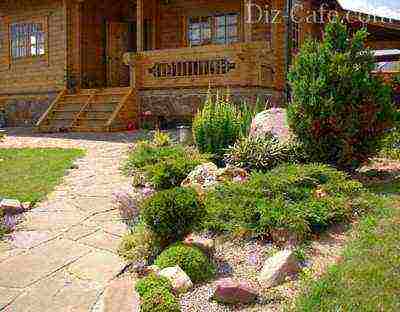
By combining molded and unshaped junipers with an exotic crown, you can create a spectacular rockery
Dwarf junipers in the form of compact bonsai and topiary are indispensable when laying a garden in an oriental style - they will advantageously decorate a stony composition and branching paths, advantageously combined with ground cover and low-growing plants: saxifrages, loosestrife, stonecrop, carnations, phlox and cereals.
Junipers with a beautiful crown color:
- bluish-silver rocky juniper of the Blue Arrow variety,
- bluish blue Meyeri and Blue Carpet,
- gray-gray rock variety Skyrocket,
- horizontal juniper of some species (Andorra Compact, Blue Chip) turns purple in winter,
- Pfitzeriana Aurea's sprawling golden-tone juniper looks great against the backdrop of the lawn.
The spectacular crown of junipers does not require frequent pruning, but varieties growing in the form of a hedge are cut regularly: in mid-summer and spring, removing dry and some lateral branches that protrude beyond the formed crown. If the juniper grows in the garden as a bonsai, then the haircut is performed in April-May and in October-November.
Choosing a variety of juniper for planting
When choosing a type of juniper for planting in the garden, you must have complete information about its characteristics: winter hardiness, plant size in adult form, crown shape and color, growing conditions and care. Junipers, which are brought to us from Western European nurseries, can be both sufficiently resistant to the severe winters characteristic of central Russia, and non-resistant, successfully growing without shelter only in the southern regions.
After acquiring a new coniferous plant (even frost-resistant), experienced gardeners recommend covering it for the first winter with spruce branches or burlap, tying up the branches in order to avoid sunburn of the needles and damage to the crown from snow.
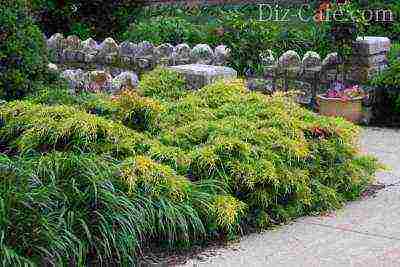
The juniper of the medium grade Gold Coast, with golden needles, is an impressive contrast to the more emerald greens.
Employees of the botanical gardens of Russia have identified juniper varieties that are suitable and unsuitable for cultivation in domestic latitudes.
Winter hardy species of juniper (Juniperus):
- ordinary (J. Communis),
- Cossack (J. Sabina),
- scaly (J. Squmata),
- horizontal (J. Horizontalis),
- Siberian (J. Sibirica),
- Chinese (J. Chinensis),
- solid (J. Rigida),
- virginian (J. Virginiana).
Non-resistant types of juniper:
- Turkestan (J. Turkestanica),
- inclined (J. Procumbens),
- Zeravshan (J. Seravshanica),
- red (J. Oxycedrus).
Successful rooting and growth of a juniper largely depends on the quality of the purchased seedlings. When purchasing planting material, you should pay attention to the following points:
- It is better not to buy plants with an open root system.
- It is advisable to purchase a juniper in a container or with an earthen lump wrapped in burlap.
- The root system and branches should show an increase in the current year.
- There should be no cracks on the trunk of the plant.
- Fresh shoots should be flexible and unbreakable.
- The color of the crown should be uniform, without brownish blotches and white flakes at the base of the needles.
- It is recommended that you choose those plants that have been grown in a container, not outdoors, and then simply transplanted into a container.
Junipers with an open root system are planted in early spring or autumn, and seedlings with an earthen ball are planted throughout the entire period from spring to autumn. For the northern regions, planting in spring is optimal - this way the seedling will have time to take root in order to more successfully endure the winter.
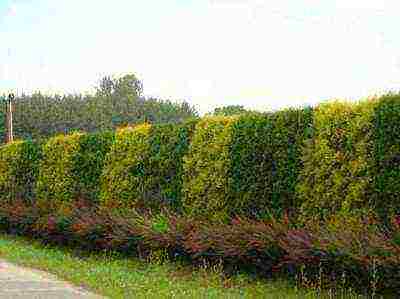
Combining junipers with different colors of needles, you can form a hedge that is unusual in color and shape
Sapling planting technology
Due to their decorativeness, junipers are a good choice for a young garden, when a group of several conifers is able, immediately after planting, to fill the voids in the landscape and form an attractive composition. For planting light-loving junipers, an open, well-lit garden area is selected, with loamy or sandy loam light soil - nutritious and sufficiently moist.
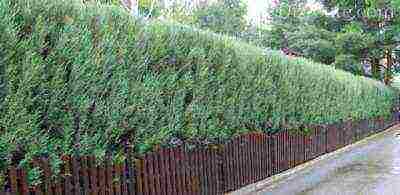
A living molded hedge of silver-blue juniper will become a catchy element of garden landscaping
If the soil is clayey and heavy, then a mixture of garden soil, peat, sand and coniferous soil (loose soil with needles, collected under spruce or pine trees in the forest) is added to the planting hole. At the same time, the soil is preliminarily drained, falling asleep on the bottom of the planting pit with broken brick or sand. Junipers grow well on lean soils, they can easily tolerate drought, but stagnant moisture in the soil is destructive for them.
The most successful soil mixture for planting juniper: 2 parts of sod land, 2 parts of humus, 2 parts of peat, 1 part of sand. It is also advisable to add 150 g of Kemira-universal and 300 g of nitrophoska to the mixture, as well as epin after planting (for optimal survival) under each seedling.
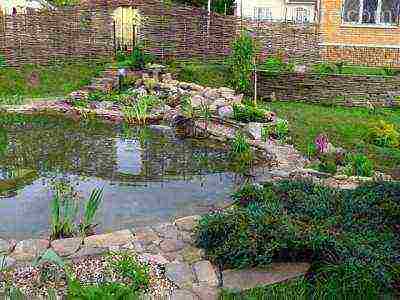
Horizontal junipers with a spread crown fit well into the design of the area near the pond
The dimensions of the planting hole depend on the size of the root system of the juniper, for example, for large species they dig a hole of about 60 × 80 cm.The plant is planted quickly so that the root system does not have time to dry out, but carefully so as not to damage the earthen ball or young roots. After planting in open ground, the juniper is watered abundantly and covered from direct sunlight.
The density of the placement of junipers on the site depends on the landscape composition - whether it will be a hedge, specimen or group planting. For junipers, the distance between seedlings when planting is selected in the range from 0.5 to 2 m. For a small garden, it is better to stay on compact species of juniper.
Growing juniper from seeds
When collecting juniper seeds for sowing, it is important to observe the time intervals - it is better to prepare not quite ripe seeds at the end of summer than finally ripe seeds in the fall. This will make it more likely to germinate. The collected planting material must be sown immediately, but you need to be prepared for the fact that, due to the hard shell, the juniper seeds will sprout only 2-3 years after sowing.
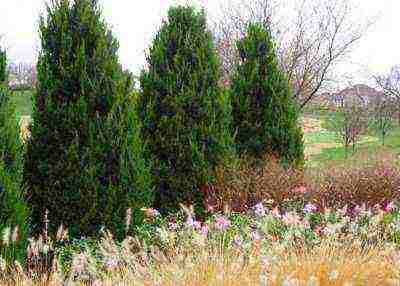
A group planting of Chinese junipers will revitalize the garden during the off-season and winter
You can plant a juniper dug in the forest on the site, having previously indicated the orientation of the parts of the world on its trunk in order to maximally simulate the features of its growth in the natural environment during transplantation. The lump of "native" land should be large, with a preserved top layer of humus.
How to apply fertilizers correctly
Subject to the selection of juniper varieties that are resistant to domestic climatic conditions, care for young plants is minimal - junipers almost do not get sick and are not affected by pests, do not require intensive feeding and spraying. In the future, it is enough just to ensure the watering of the juniper in dry years and 2-3 times per season to support it with nitrogen or complex fertilizers.
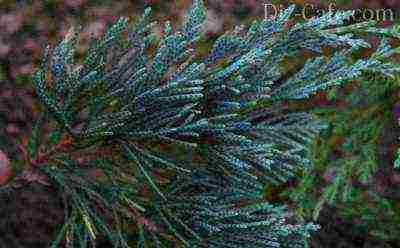
Different varieties of junipers have differently colored needles, but the needles of a bluish-blue hue look especially beautiful
In no case should you fertilize conifers with bird or cow humus - this burns the roots of the juniper, and the plant dies. Also, you cannot loosen the soil around the junipers - due to the fact that the root system of conifers belongs to the surface type, the nutrition of the trunk will deteriorate, and the plant will begin to wither. For a juniper, it is enough to mulch the soil with coniferous soil harvested in the forest.
Winter care
In winter, the formed crowns of junipers can disintegrate under the weight of snow, and some branches can break. To avoid such troubles, the crowns of molded junipers are tied in advance in the fall. Certain types of junipers are sensitive to changes in day and night temperatures in early spring, active winter and spring sun and require shelter in February-March. Needle burns lead to a change in the green color of the crown of the conifers to a brown-yellow hue and, consequently, to the loss of decorativeness of the juniper.

Plumosa horizontal juniper acts as a ground cover plant for a rock garden
If the buds of the ephedra remain alive during a sunburn, then the young shoots gradually cover the burnt places, but if the buds have died, then the branches affected by frost must be cut off to healthy wood and treated with garden pitch.
In order for the juniper needles to retain their brightness in winter, the plant must be regularly watered, fertilized in spring and at the end of summer with granulated baits, and sprayed with micronutrient fertilizers on the needles.
Gardeners practice these types of juniper shelter for the winter:
- Snow. An excellent option for miniature and creeping forms - simply throw snow on the branches of the ephedra. But in case of heavy snowfall, it is recommended to make a protective frame.
- Lapnik. They are fixed on the branches in tiers, moving from the bottom to the top of the juniper.
- Non-woven and woven fabrics. Ephedra are wrapped in spunbond, burlap, kraft paper (in two layers), light cotton cloth and tied with a rope, leaving the lower part of the crown open. The film cannot be used - the plant will rot.
- Screen. Installed from the maximum illuminated side of the plant.
Lutrasil is not suitable for sheltering a juniper - it lets in the sun's rays, and a shelter from cardboard boxes is also not entirely successful. In the experience of gardeners, metallized insulation, used for laying laminate flooring, is excellent as a shelter for ephedra. To do this, in October (while the ground is still not frozen), pegs are driven in around the juniper, and the plant itself is wrapped in a substrate in November.
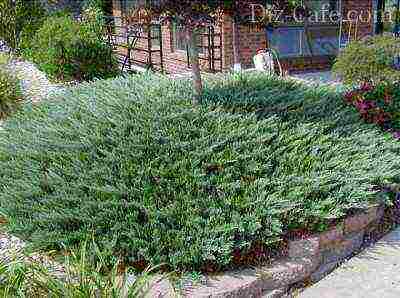
The horizontal Bar Harbor juniper with a rounded crown effectively complements the solitary deciduous planting
Frost-resistant types of juniper that do not burn in the sun: Cossack, medium varieties (Hetzi, Old Gold, Mint Julep), Chinese Gold Star, Pendula and Pfitzeriana varieties. Subspecies of common juniper are badly burned in the winter and spring sun.
Location on the flowerbed: 8 beautiful patterns
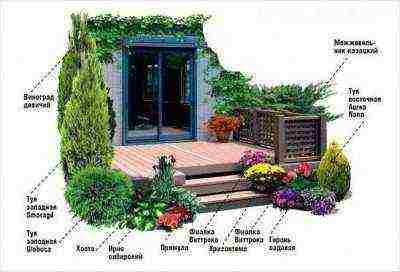
Juniper Cossack is one of the most frost-resistant varieties, ideal for planting in central Russia
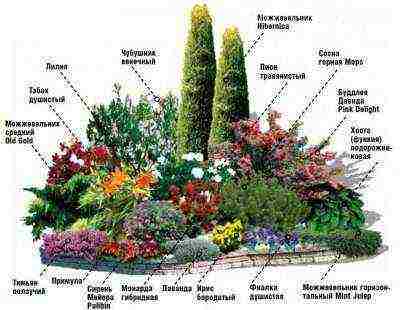
Hiberic's columnar juniper acts as a focal point in the flower bed

Several types of juniper can be combined on a flower bed: rocky, horizontal, Chinese - any combination will be successful
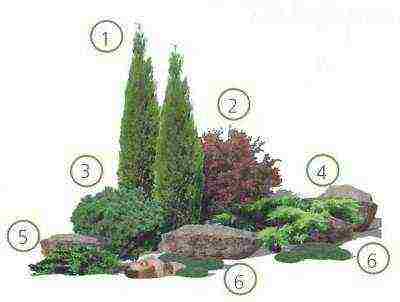
1. Thuja western "Holmstrup". 2. Barberry Thunberg "Red Chief". 3. Mountain pine "Mops". 4. Juniper medium "Old Gold". 5. Juniper Cossack "Tamariscifolia". 6. Ground cover perennials (bryozoan, stonecrop)

1. Rocky juniper "Blue Arrow". 2. Juniper rocky molded "Skyrocket". 3. Juniper scaly molded "Meyeri". 4. Mountain pine "Mops". 5. Juniper horizontal "Blue Chip". 6. Juniper leaning "Nana"
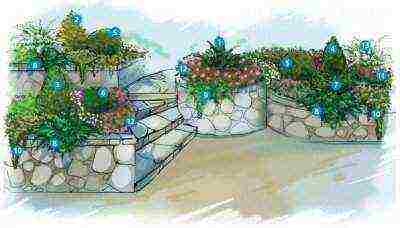
1. Chinese juniper "Blaauw" or "Blue Alps". 2. Thuja western "Stolwijk" or "Rheingold". 3.Thuja eastern "Aurea Nana". 4. Canadian spruce "Conica". 5. Thuja western "Tiny Tim" or "Little Champion". 6. Mountain pine "Gnom". 7. Colorado spruce "Glauca Globosa" or European "Nidiformis". 8. Juniper horizontal "Blue Chip" or "Prince of Wales". 9. Juniper horizontal "Wiltonii". 10. Dammer's cotoneaster. 11. Ground cover roses. 12. Flowers: petunia, subulate phlox, aubrieta, thyme, verbena. 13. Spirea "Snowmound"
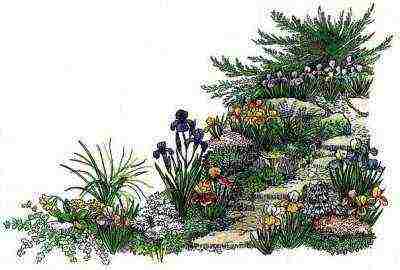
Juniper with an original crown plays the role of an accent on an alpine slide

1. Molded Cossack juniper. 2. Siebold's sedum. 3. The sedum is caustic. 4. Iris dwarf. 5. Garden iris (bearded, medium-sized). 6. Ear primrose. 7. Iberis is evergreen. 8. Sod meadow. 9. The hybrid was rejuvenated. 10. Soddy saxifrage. 11. Muscari tufted. 12. Spoon-leaf bell
Types and varieties of juniper
The decorativeness of the planting of junipers significantly depends on the correctly selected variety - its dimensions, taking into account the growth, the shape of the crown, the color and texture of the needles. Varieties belonging to the same species of juniper can vary significantly in their external characteristics - this is also worth considering.
Juniper scaly:
- Meyeri. Height 1 m, growth rate 10 cm per year. The needles are silver-blue. Mixborders and bonsai.
- Blue Carpet. Height 0.6 m, diameter 2-2.5 m. Creeping branchy crown. The needles are silver-blue. Unpretentious, growing rapidly. The lower tier of landscape compositions.
Juniper medium:
- Old Gold. Height 0.4 m, diameter 1 m. Wide rounded crown of yellow-gold color. Single planting on the lawn, in the rock gardens.
- Mint Julep. Height 1.5 m, diameter 2-3 m. Sprawling crown with curved branches and scaly green needles. Group planting, alpine slides, tamping of tall shrubs.
- Gold Star. Height 1 m, diameter 2.5 m. A low-growing shrub with a spreading crown and needles of a golden-green tone. Low cut or loose hedges, decorating gutters and drainage wells.
- Pfitzeriana compact. Height 0.8 m, diameter 1.5-2 m. Sprawling crown, needle-shaped green needles. Grows quickly, tolerates haircuts well. Curbs, clumps of evergreens with different colors of needles, molded and unshaped hedges, the organization of the lower tier in large-scale landscape compositions.
Red cedar:
- Hetz. Height 1 m, diameter 2-2.5 m. Growth 30 cm per year. Sprawling, rounded crown with scaly silvery-blue needles. Tolerates haircuts well. Single and group boarding.
- Canaerti. Height 5-7 m, diameter 2-3 m. Annual growth 30 cm. Columnar crown with dark green needles. Solitaire, bands, hedges.
- Gray Oul. Height 1 m, diameter 2.5 m. Growth 20 cm per year. Sprawling crown with scaly silvery-blue needles and purple shoots. Shaped compositions.
Juniper horizontal:
- Blue Chip. Height 0.4 m, diameter 2 m. A low-growing dwarf shrub with needle-shaped needles of a bluish-blue tone. Rock gardens, heather gardens, retaining walls.
- Blue Forest. Height 0.3 m, diameter 1.5. Creeping ground cover crown with blue needles. Strengthening the slopes, lower tiers of rock gardens, container planting.
- Andorra compact. Height 0.4 m, diameter 1.5 m. Flat-round cushion-shaped crown with blue-gray scaly needles. Low curbs, decorating the slopes and tiers of the garden.
- Andorra compact Veriegata. Height 0.4 m, diameter 1.5 m. Cushion-shaped crown with radiant shoots and bright green needles with whitish blotches on the tips of the branches. Mixed groups, rocky gardens.
- Wiltoni. Height 0.1 m, diameter 2 m. Branched ground cover crown with silver-emerald needles. Large groups, rock gardens, juniper lawns.
Juniper Chinese:
- Strickta. Height 2.5 m, diameter 1.5 m. Cone-shaped crown with greenish-blue needles. Single and group planting, growing in flowerpots.
- Obelisk. Height 3 m, diameter 1.2-1.5 m. Columnar crown with bluish-green needles.
- Monarch.Height 2 m, diameter 1.5 m. Asymmetric columnar crown. Single and group landings.
- Kurivao Gold. Height 2 m, diameter 2 m. Spreading openwork crown of rounded shape with green needles and young shoots of a golden hue. Single planting, mixed and coniferous groups, rock gardens.
Rocky juniper Skyrocket. Height 3 m, diameter 0.7 m. Annual growth 10-20 cm. Pyramidal crown with short bluish-green needles. Vertical accent in rock gardens, alley plantings, lawns, contrasting compositions and hedges.
Common juniper Hibernica. Height 3-5 m, diameter 1-1.2 m. Columnar crown with bluish-steel prickly needles. Solitaire on lawns, group plantings and compositions with deciduous species.
Juniper Cossack. Height 1 m, diameter 2 m. Sprawling crown with herbaceous green needles. Hedges, single and group plantings.
The variety of colors and shapes of junipers allows you to create spectacular landscape compositions, combining them with other coniferous and deciduous species of shrubs or trees, as well as flowers and other garden plants.
Rate the article:
(3 votes, average: 3.7 out of 5)
A plant such as juniper (Juniperus) is also called juniper or heather. It relates to the genus of evergreen coniferous shrubs or trees of the cypress family. In nature, they can be found in the Northern Hemisphere from the Arctic to the subtropical mountain regions. In the classification, the old Latin name of this plant "juniper" was retained by Karl Linnaeus, it was mentioned in the writings of the poet Virgil, who lived in Ancient Rome. This genus currently unites about 70 species of various plants. Most creeping species prefer to grow only in mountainous areas, but a tree belonging to this genus has a height of about 15 meters and is found in the forests of Central Asia and America, as well as in the Mediterranean. Outwardly, this plant is similar to a cypress, and it can live 600-3 thousand years. In places where juniper grows, the air is incredibly clean. In antiquity, it was believed that juniper is the number one remedy for a snakebite; in Russia it was used to make dishes, in which milk did not turn sour even in the heat. Various remedies for diseases have long been made from the root, cones and essential oils of the plant. Ground juniper fruits are widely used in cooking, as a seasoning for meat dishes, as well as in the preparation of sauces, marinades, soups, pates and liqueurs. The wood of certain species of this plant is used in the manufacture of pencils, canes and various crafts.
Features of a juniper (shrub)
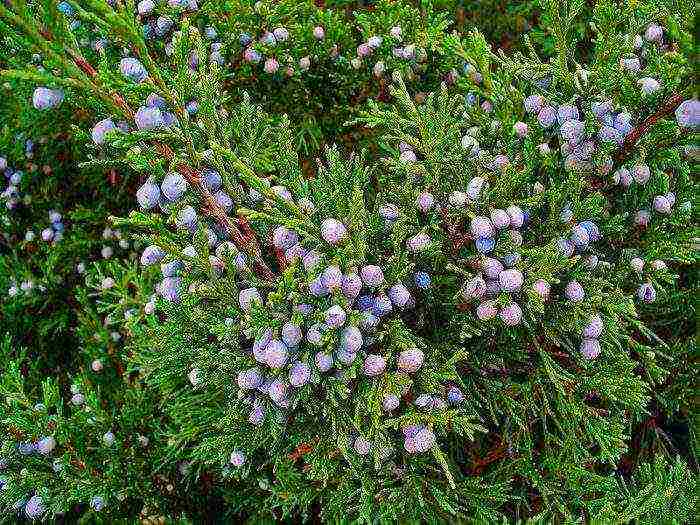
Juniper shrub is more popular among gardeners, its height can reach 1-3 meters. But sometimes tree-like forms are found in gardens, the height of such a plant is 4-8 meters, but in some cases it is about 12 meters. The erect stem is branched. In young specimens, the bark is brownish-red, while in the old plant it is brown. Needle-shaped or scaly leaves are collected in several pieces in whorls. Such a shrub is dioecious. Fragrant with a pleasant spicy taste, female oval cones reach 0.5-0.9 centimeters in diameter, they are colored green. Male cones are similar to elongated oval spikelets, which have a rich yellow color and are located in the leaf sinuses. Ripening of these cones takes place in the second year. Inside they have a dozen seeds, while on the surface there are tightly closed fleshy scales.
Many different types of such a plant are cultivated, while it is grown both outdoors and in the house. For example, juniper bonsai are very popular.
Juniper planting
What time to plant
It is recommended to plant a seedling in the garden in spring (April or May). And such a shrub can be planted in the autumn (October). This plant is very fond of light, but the common juniper can grow in a slightly shaded place. There are no special requirements for the soil. However, it is recommended for him to choose loose, wet, limestone or sandy soil. The acidity of the soil should be within the pH range of 4.5–7 (depending on the type and variety of juniper).
Juniper seedlings
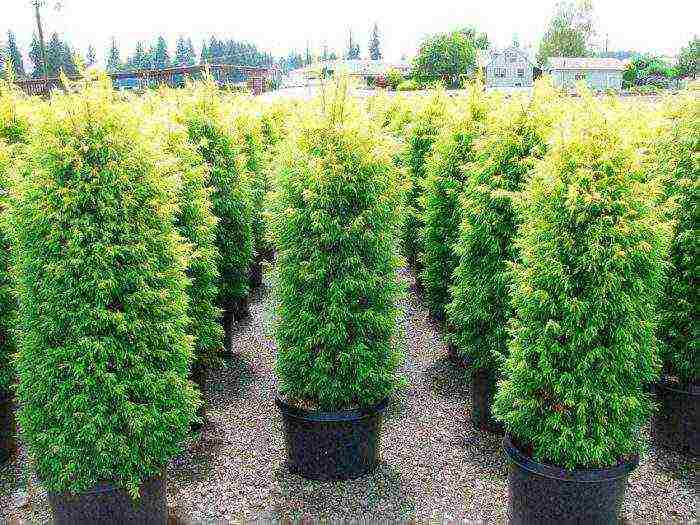
For planting in the garden, seedlings that are 3-4 years old are suitable. It is recommended to buy them in garden centers or nurseries that have proven themselves well. In the case when the seedling is in a container, the volume of which is from 3 to 5 liters, then it takes root well and begins to grow quickly. If you use fairly large seedlings, then some experience will be needed to plant them, and they will take root much more slowly. Inspect the seedling carefully before purchasing. If there are any signs of illness, then it is better not to acquire such a copy. When planting a plant, try to keep the clod of earth on its roots intact. The fact is that if the soil crumbles, it will lead to injury to the tips of the roots, as a result, the seedling will hurt for a long time and ultimately be able to die. If the seedling is planted in a container, then it can be planted in the garden at any time during the season, but it is better to exclude hot days. Before planting a plant, its root system must be immersed in water for a couple of hours. Young seedlings with open roots are recommended to be planted in spring or in the last summer days in wet weather. If desired, the roots of the shrub can be treated with a root growth stimulating agent (Kornevin) just before planting.
How to plant
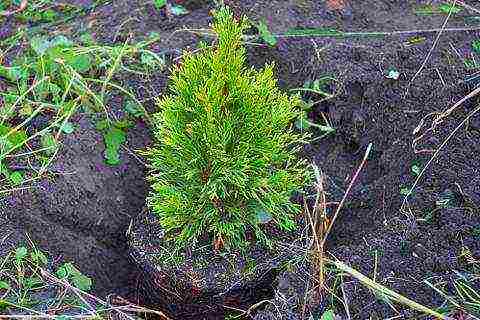
If the plant grows large enough, then 150-200 centimeters should be left between the bushes. If the bushes are compact, then the distance between them should be about 50 centimeters. The depth of the hole directly depends on the size of the seedling's clod of earth, while its size should exceed the root system by 2 or 3 times. If the seedling is not very large, then a hole of 50x50x50 centimeters is enough for it. Half a month before landing, a layer of broken brick and sand should be laid out at the bottom of the landing hole for drainage, while its height should be from 15 to 20 centimeters. After that, 2/3 the hole is filled with a mixture of nutrients, consisting of sand, soddy clay soil and peat (1: 1: 2), into which 200 to 300 grams of nitroammophos should be poured and everything is mixed well. If you are planting Verginsky juniper, then add ½ part of a compost bucket to the soil. Moreover, if it is planted in poor sandy soil, then you also need to pour in half a bucket of clay. When planting Cossack juniper in the ground, you need to pour from 200 to 300 grams of dolomite flour. After half a month, the soil will settle and a seedling must be planted. A seedling should be placed in the hole and filled with a soil mixture of a similar composition, but without fertilization. After planting a large seedling, its root collar should rise 5-10 centimeters above the ground level. In the case when the plant is not very large, after planting its root collar should be flush with the soil surface. The planted juniper must be watered, and when the liquid is absorbed, you need to cover the surface of the trunk circle with a layer of mulch (sawdust, peat or chips), its thickness should be from 5 to 8 centimeters.
How to care for the garden
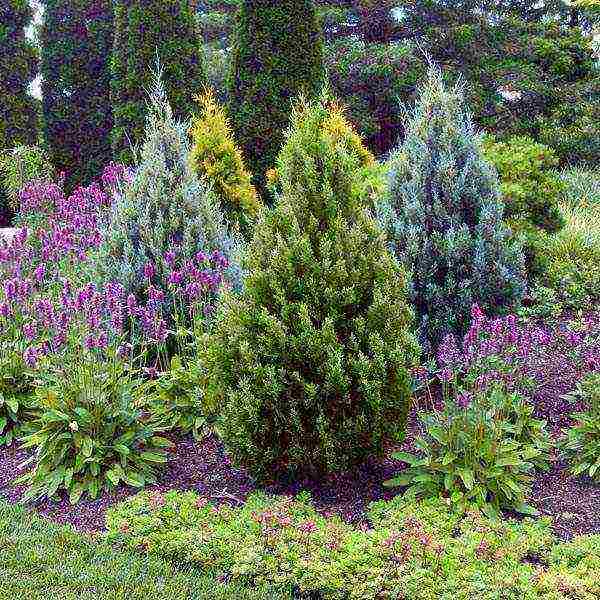
Growing
Growing a juniper is easy enough. During the season, watering should be done only in prolonged heat, while 1–2 buckets of water are taken for 1 adult specimen.Juniper reacts favorably to foliage moisture, which is recommended to be done once a week, especially this procedure is required for Chinese and common junipers. Periodically, the surface of the soil of the trunk circle should be loosened and at the same time it is necessary to pull out the weeds. It is recommended to feed the juniper in springtime, for this, 30 to 40 grams of nitroammofoska should be distributed over the surface of the trunk circle. Fertilizer is embedded in the soil, and then watered without fail. In the event that the plant is planted in very poor soil, then it should be fertilized in this way throughout the growing season, but the break in feeding should be at least 4 weeks.
Pruning
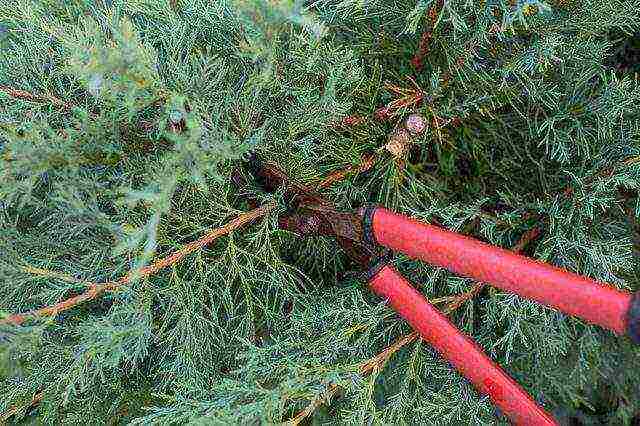
Juniper pruning is usually done when they want to make a hedge from this shrub. Otherwise, trimming should not be performed. However, in the event that you want to form a bush, then you need to be extremely careful. The fact is that if you cut off something extra, then it will take a very long time to recover, since this is a slow-growing plant. Experienced experts recommend sanitary and thinning pruning, and you can also trim those branches that are too long or look sloppy.
Transplant features

It happens that an already mature plant needs to be transplanted to another place. It should be remembered that for an adult plant, a transplant is a great stress, and even more so for a juniper. Is it possible to transplant a shrub so as to harm it as little as possible? How exactly to prepare a planting hole for a given plant, and what size it should be, is discussed above. The bush itself must also be prepared for transplantation. In springtime, you need to retreat from the trunk or bush from 30 to 40 centimeters, then take a sharp shovel and use it to cut the soil to the depth of the bayonet. This way you can separate the peripheral young roots from the juniper root system. Then you need to wait until the onset of the autumn or next spring period. During this time, young roots will have time to grow inside the clod of earth, which has been cut off. As a result, the plant can be transplanted almost painlessly.
Harmful insects and diseases
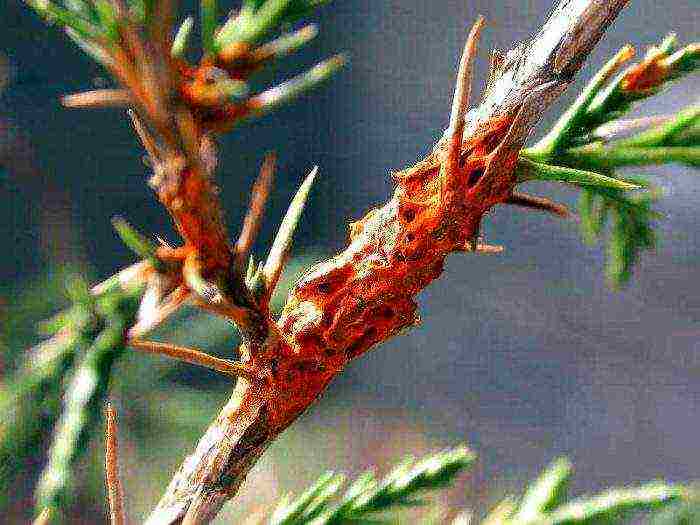
Often this shrub is affected by a fungal disease such as rust. In an infected bush, spindle-shaped thickenings appear on the shoots, cones, needles and skeletal branches. At the root collar, swelling and sagging appear, while on their surface the bark dries, crumbles, as a result, not very deep wounds are exposed. Infected branches dry up and die, while the needles turn brown and fall off. In the event that the plant is not treated, then it will die. In order to prevent this, as soon as the disease is noticed, it is necessary to cut off the infected branches, while the wounds and cuts are disinfected with a solution of copper sulfate (1%), and after that they must be smeared with garden varnish or Ranet paste. Those branches that have been cut must be destroyed. For preventive purposes, it is recommended to spray the juniper in spring and autumn with a Bordeaux mixture (1%) or with a similar action. Also, the shrub can suffer from alternaria, shute, nectriosis of the bark of branches, biotorella cancer and drying out of branches. All of these diseases can be cured in the same way as rust. It must be remembered that if you take good care of the bush, then it will not become infected with any diseases and pests.

Such harmful insects can settle on a juniper, such as:
- Miner moth. You can get rid of it with the help of Decis solution (2.5 grams of substance per bucket of water). Processing should be carried out 2 times with a break of half a month.
- Aphid. In this case, the treatment should also be carried out 2 times with a break of 2 weeks with Fitoverm solution (for 1 bucket of water, 2 grams of substance).
- Spider mite. The infected plant must be treated with a Karate solution (50 grams of substance for 1 bucket of water).
- Shields. For destruction, you should use a solution of Karbofos (for 1 bucket of water 70 grams).
Features of growing in Moscow
Growing juniper in Moscow and the Moscow region, where the climate is cool enough, is no different. This plant tolerates wintering well, however, it is still recommended to cover young plants for the winter with spruce branches.
Reproduction of juniper
How can you multiply
Seedlings of this plant can be purchased quite easily, and therefore there is no particular need to use various methods of reproduction of a juniper. But if you still want to grow a juniper with your own hands, then you need to remember that creeping forms can be propagated by layering, and tree and bush forms can be propagated by green cuttings and seeds.
Reproduction of juniper by seeds
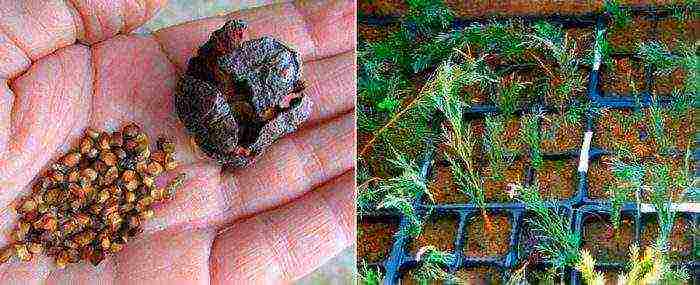
Before sowing the seeds of a given plant, they need to be prepared. To do this, they must be stratified, and this requires cold. In a box filled with earth mixture, you need to sow seeds, then this container is taken out into the street and placed under a snowdrift. The seeds should stay there for 4–5 months. The prepared seeds are sown in open ground in May. If desired, in May, you can sow unprepared seeds, but in this case you need to know that the first shoots will appear only next year. In some species of such a plant, the seeds have a rather dense shell in this regard, before they are planted, they must be scarified. So, to accelerate germination, the seeds are exposed to acid or the shell is mechanically damaged. So, the most often used method is when the seeds are placed between two boards, upholstered with sandpaper from the inside. Then they must be rubbed. After the seeds are stratified, they are sown into the ground, while the planting depth should be from 2 to 3 centimeters. It is quite easy to care for the sown seeds. It is necessary to sprinkle the surface of the bed with a layer of mulch, water if necessary, during the first 14 days you need to protect the bed from direct sunlight. You should also systematically loosen the surface of the beds and pull out weeds. At the age of three, it will be possible to transplant a seedling to a permanent place, transferring it along with an earthen lump.
Reproduction of juniper cuttings

Decorative forms do not propagate by seeds; cuttings are used for this. They should be prepared in the spring, while cuttings are cut from young shoots that have time to lignify. The length of the cutting should be from 5 to 7 centimeters, while it must have 1 or 2 internodes, as well as a heel. To do this, the stalk should not be cut off, but it is torn off by hand in such a way that a piece of bark from the parent plant remains at its end. Immediately, the cutting should be treated with a root growth stimulating agent. Then the prepared material for planting is planted according to the 7x7 scheme in an earth mixture consisting of sand and peat (humus), taken in a ratio of 1: 1, while the surface must be sprinkled with coarse sand (layer thickness from 3 to 4 centimeters). After planting, each cutting separately must be covered with a glass jar. It is necessary to deepen the cutting by 15–20 mm, in this regard, rooting will occur in the sandy layer. By the onset of the autumn period, the cuttings will take root, however, transplantation to a permanent place can only be carried out after 2 years.
Reproduction by layering
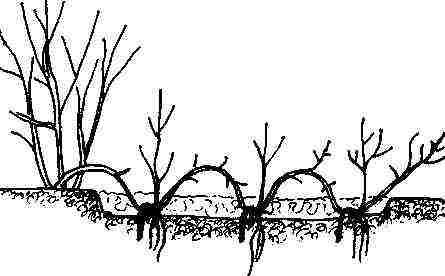
If the juniper is creeping, then layering can be used for its reproduction. At the same time, the plant can be propagated in this way during the entire period of active growth. For layering, you need to choose young, barely ripe branches, since they very quickly give roots. First you need to loosen the surface of the soil around the plant, mix it with loose peat and river sand, and then moisten it.To a height of 20 centimeters from the base, the layers must be freed from the needles, then this part should be bent to the soil surface and fixed with pins. After 6–12 months, the cuttings will give roots, but during this time it should be watered systematically, as well as spud. After young shoots grow on the layer, they will need to be disconnected from the parent plant and planted in a permanent place.
Wintering juniper in the country
Autumn
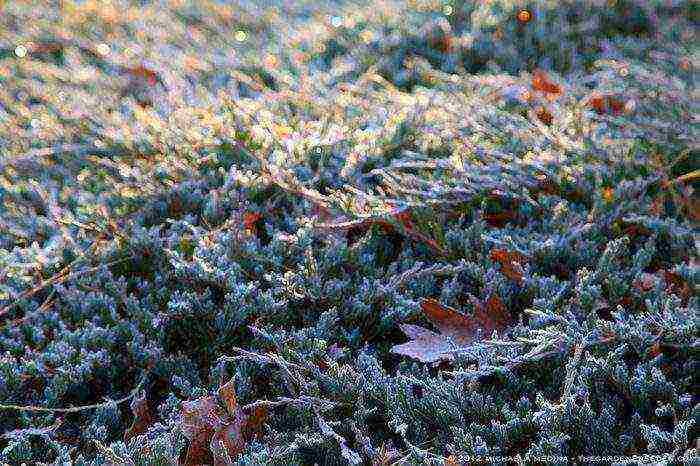
In the autumn, this plant must be prepared for wintering. For this, the juniper is pruned for sanitary purposes, while the injured, dried out and growing branches and shoots are cut off. Then the plant and the surface of the trunk circle are treated with a solution of Bordeaux liquid (1%) in order to prevent various diseases and harmful insects.
Winter
Juniper is frost resistant. In areas with mild winters, you do not need to cover it for the winter, but you should pull off the branches with twine. It is recommended to cover young plants for the winter with spruce branches.
The main types and varieties of junipers with a photo
In landscape design, juniper is very popular, so experts are trying to bring out new, more interesting varieties and forms. Many natural species are also grown quite successfully by gardeners in their garden plots. Below will be presented the most popular species, varieties and forms of this plant, as well as their brief description.
Common juniper (Juniperus communis)

This is a shrub or tree, the height of which can vary from 5 to 10 meters. The trunk reaches 20 centimeters in diameter. The tree has a dense cone-shaped crown, and the shrub is ovoid. The fibrous bark is colored brownish-gray, while the shoots are brownish-red. The green, pointed, needle-like needles are triangular. The length of the needles can reach 15 mm, and they stay on the branches for 4 years. Blooming is observed in May. The female flowers are green and the male flowers are yellow. The life span of this plant is about 200 years. Cones are round in shape in diameter up to 10 mm, while immature they have a green color, and mature ones - bluish-black, there is a coating of wax on their surface. Varieties of this plant:
- Depressive (pinned down) - this creeping wide-flat form can reach a height of 100 centimeters. Her needles are not as long and thin as in the main species.
- Montana - such a creeping form reaches a height of 20 centimeters. The triangular branches are thick and short.
- Green Carpet - This dwarf creeping shrub has a flat crown. Its soft needles are pale green. For 10 years, the plant can grow only 10 centimeters in height. In this case, the crown in diameter can reach 150 centimeters.
- Columnaris Is a columnar shape. The plant has a blunt top, reaches 150 centimeters in height and 30 centimeters in width. On the ascending shoots there is a short needles, at the bottom it is greenish-blue, and at the top it has a whitish-blue strip.
There are also a very large number of varieties and forms of this species, for example: Horstmann, Erekta, Nana Aurea, Meyer, Pyramidalis, Repanda, Sentinel, etc.
Juniper virginiana (Juniperus virginiana), or "pencil tree"
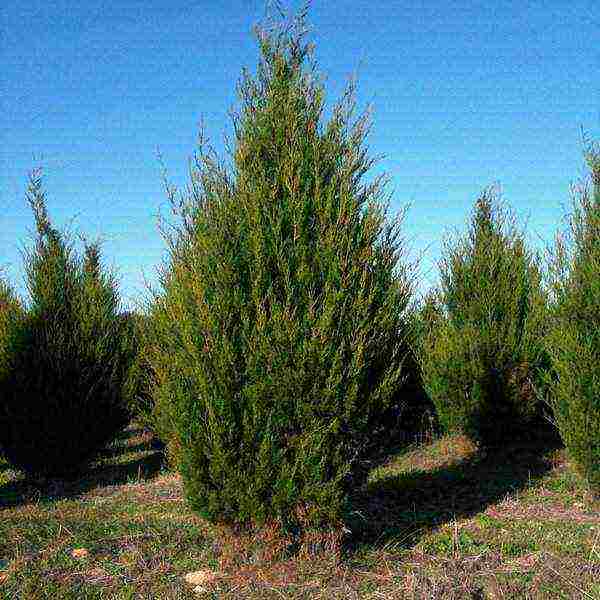
Such an evergreen tree can reach a height of about 30 meters. In young specimens, the crown has a narrow ovoid shape, then gradually it becomes prostrate due to widely spaced branches. The trunk can be up to 1.5 meters in diameter. The peeling bark is colored brownish red or dark brown, and in young shoots it is green. Small, scaly or needle-shaped needles have a dark green color. In diameter, the spherical berries can reach 0.6 centimeters, they have a dark blue color and a bluish bloom. Cultivated since 1664.
The most popular with this species is such a cultivar as Blue Arrow. It has several forms: pin-shaped, columnar and shrub. Among them are Gray Oul, Glauka and Boskop Purple, which have blue needles, Robusta Green and Festigiata - greenish-blue needles, Canaertia - dark green needles, Silver Sprider - greenish-silver needles.
Juniper horizontal or prostrate (Juniperus horizontalis)
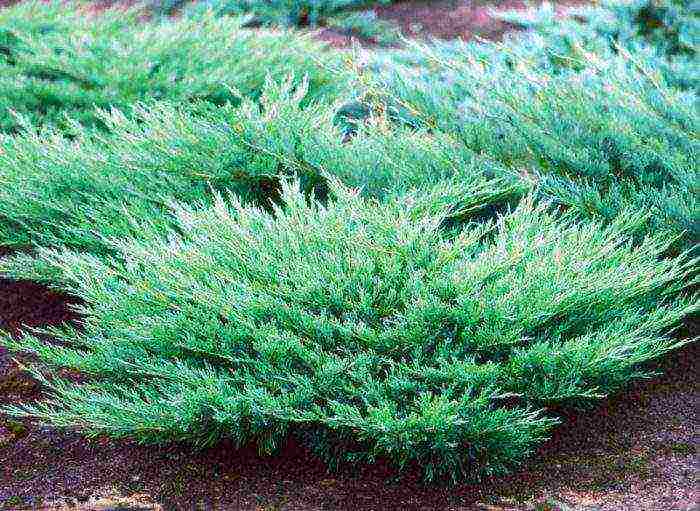
Under natural conditions, this plant can be found in Canada and the United States. It prefers to grow in the mountains, on the sandy coasts of rivers and lakes, as well as on the hillsides. This creeping form can reach a height of about 100 centimeters. It has long branches with densely spaced tetrahedral shoots, painted in a greenish-blue color. The needles can be green or blue, but in winter they have a brownish tint. In diameter, the fruits can reach 0.9 centimeters, they have a black-blue color and a bloom of light blue. This species has been cultivated since 1840. The most popular forms:
- Andorra Compact - this cultivar in height can reach from 30 to 40 centimeters. The crown is about 100 centimeters in diameter and has a pillow-like shape. The branches go up obliquely. Small, scaly needles are colored greenish-gray, but in winter they turn purple.
- Plumosa (Andorra Jupiter) - in height such a creeping shrub can reach up to half a meter, and in width - about 2.5 meters. The branches lie on the surface of the ground. On the feathery branches there are subulate needles. The needles are light greenish-gray in color, but in winter they take on a purple hue.
- Prince of Wales - the height of this creeping shrub can reach 30 centimeters, while the crown has a diameter of up to 250 centimeters. The bark is brown in color. Dense blue needles in winter acquire a light red hue.
Juniper Cossack (Juniperus sabina)

In height, this creeping shrub can reach 150 centimeters. It grows rather quickly in width, as a result of which dense thickets are formed. Less often, you can meet tree-like forms, their curved trunks can reach a height of 4 meters. This species has 2 types of greenish-blue needles, namely: in young specimens - acicular, in adults - scaly. Such a shrub has a characteristic feature, if you grind its needles or a shoot, then you can feel a pungent smell. This is due to the fact that the plant contains sabinol (poisonous essential oil). Cultivated since 1584 The most popular forms:
- Capressifolia - in height, this undersized shrub can reach half a meter. It has a wide crown. The shoots are open, move away from the base of the plant and rise up. Scaly needles are bluish-green in color. At the bottom of the crown, needle-like needles sometimes come across.
- Femina - this shrub reaches a height of 150 centimeters, and its crown has a diameter of about 500 centimeters. The color of the bark is brown-red, while on the shoots it is dark green. Scaly needles smell unpleasant and are poisonous, painted in a dark green color.
- Mac - a bush in height can reach from 150 to 200 centimeters, while the crown has a diameter of about 8 meters. The color of the bark is grayish red. In the lower part of the crown, needle-like pointed needles are green, and in the upper part, they are gray.
Chinese Juniper (Juniperus chinensis)
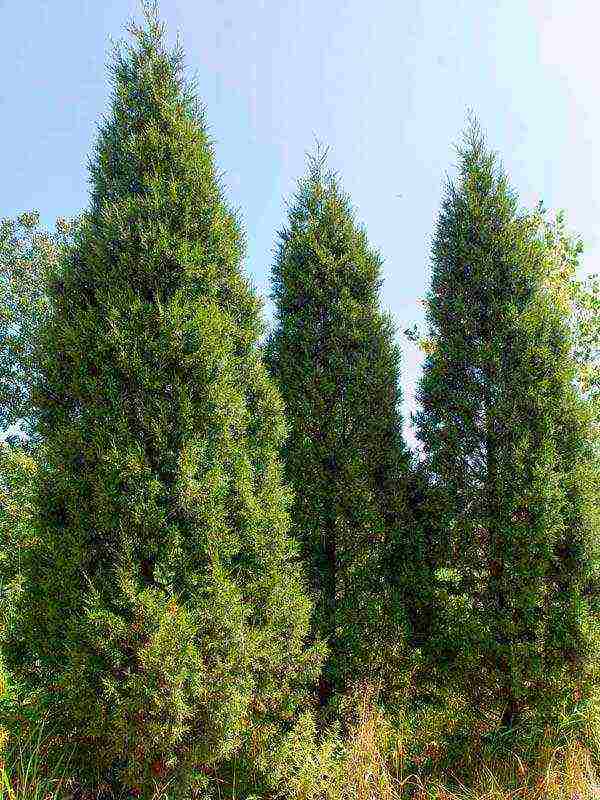
This is a tree with a pyramidal crown, which reaches a height of 8 to 10 meters. However, sometimes there is a bush pressed to the ground or spread out. The peeling bark is grayish red and the shoots are dark green. The foliage is scaly, but at the bottom of the crown or in young specimens there are thorny needle needles. Popular varieties:
- Strickta - a narrow-headed plant branches strongly. The branches are evenly spaced and raised.Straight shoots are short enough. The needles are needle-like, in the upper part they have a bluish-green color, and in the lower part - as if covered with frost. In winter, the needles turn yellow-gray.
- Olympia Is a narrow-columnar form. The branches are raised, the branches are short. There are 2 types of needles: scaly light blue and needle-like bluish green.
- Japonica - dwarf form, it is found creeping, as well as pin-shaped, reaching a height of 200 centimeters. The short branches are quite dense. The spiny, scaly, sharp foliage is pale green in color.
- Gold Coast - in height such a shrub can reach 100 centimeters, while the diameter of the crown is 300 centimeters. The needles are yellowish-golden, they become darker after the fall.
Rocky juniper (Juniperus scopulorum)
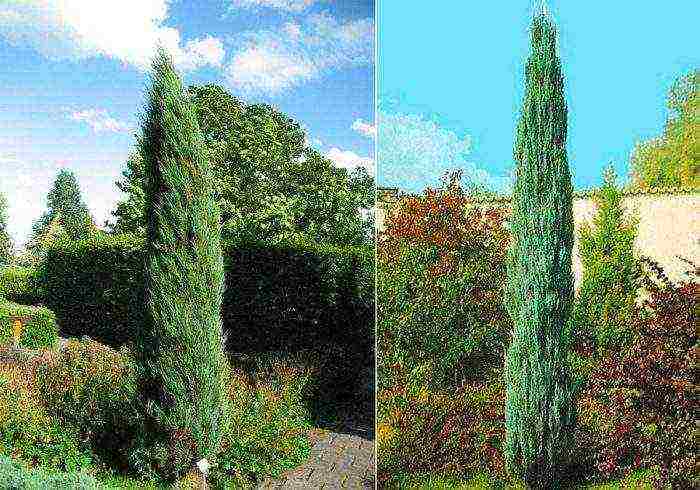
The homeland of such a plant is North America. The species is represented by a shrub or tree, which reaches a height of 18 meters. The crown begins almost from the base and has a spherical shape. Young shoots are 15 mm thick, they are colored pale green or bluish green. In most cases, scaly needles are found, but there are also needle-shaped leaves. On the surface of the dark blue fruit, there is a bluish bloom. Popular varieties:
- Repens Is a creeping shrub. On low-lying branches there are feather-like branches that rush upward. The length of the needle-like leaves is about 0.5 centimeters, they are blue at the top, and bluish-green at the bottom.
- Springbank - the height of such a narrow-gleaming juniper is about 200 centimeters. Its upper branches are flexible and spaced apart, and the tips of the shoots are almost threadlike. Scaly needles are bluish-silvery in color.
- Skyrocket - Dutch tall cultivar with a narrow habit. When the plant reaches 3 years old, its height will be 10 meters. There are straight shoots and greenish-gray needles.
Scaly Juniper (Juniperus squamata)
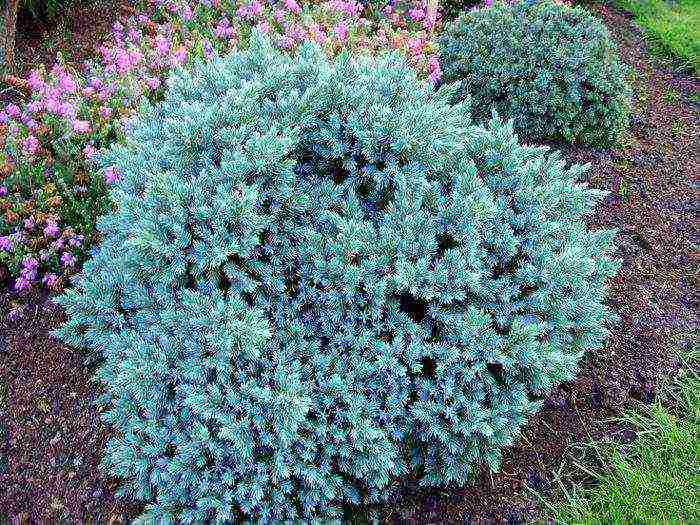
This species is quite variable, and it is represented by an evergreen shrub that can reach a height of 150 centimeters. The color of the bark is dark brown. Tough, sharp, lanceolate needles from below are colored dark green, and from above they have a whitish tint due to stomatal stripes. Fruit color is black. Cultivated since 1824 Popular varieties:
- Blue Star - the dwarf Dutch cultivar reaches a height of 100 centimeters. The diameter of the dense semicircular crown is about 200 centimeters. The needles are whitish-blue, they look most beautiful at the end of spring and early summer.
- Meyeri - a decorative form of a shrub. While the plant is young, it branches strongly, and the height of an adult specimen varies from 2 to 5 meters. The needles are very beautiful bluish-white.
- Rodery - an upright shrub has a kegle-like dense shape. Its height is about 150 centimeters. Needle short leaves are quite sharp, they are blue above and green below.
Juniper medium (Juniperus x media)
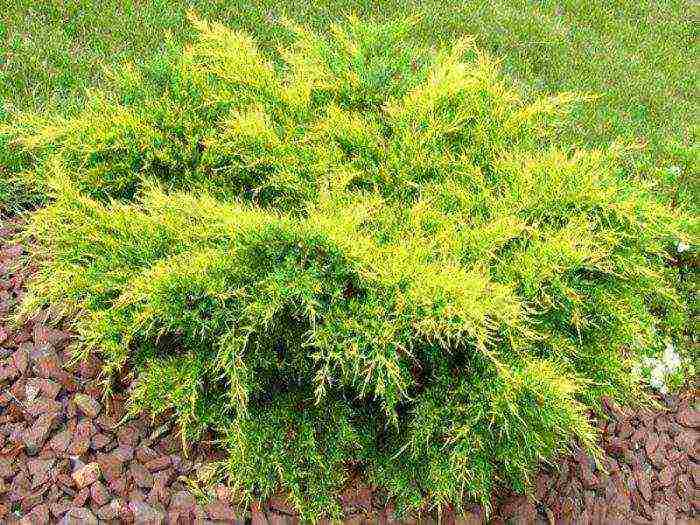
This hybrid is the result of crossing Chinese and Cossack junipers. This shrub has arched shoots with drooping ends. There are two types of needles: inside the crown it is needle-like, and the rest is scale-like. During growth, it has a pale green color, but darkens over time. The height of adult plants is 300 centimeters, while the width is 500 centimeters.
The most popular variety is Mint Julep. It is a sprawling shrub that grows quickly. The shape of the crown is wavy. At the age of ten, the plant is 150 centimeters tall and 300 centimeters wide. Since the size of the shrub is large enough, it is often planted in large gardens and parks.
Also cultivated are such species as: Daurian, recumbent or inclined, false Cossack, oblong, Sargent, Siberian, hard, Turkestan. And also other types of varieties and shapes.
Juniper properties
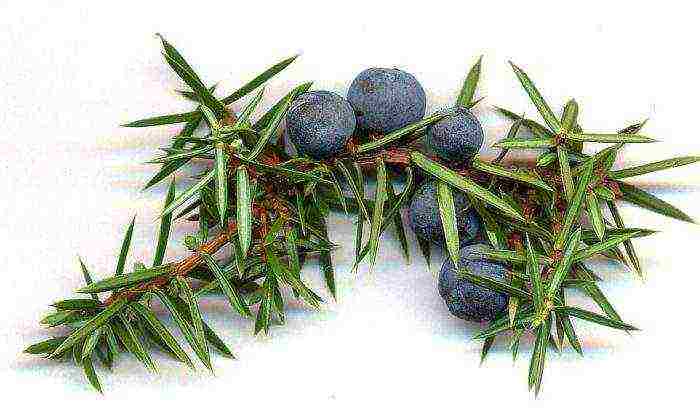
Healing properties
For a long time, such a plant has been considered a cure for any disease. Young shoots, roots are considered medicinal, but cones are often used for treatment. The roots will help heal tuberculosis, bronchitis, skin diseases, stomach ulcers. The plant relieves toothache, swelling, normalizes heart function, removes inflammation in the lung and bronchial tissue, normalizes blood pressure and blood circulation, eliminates constipation. Diathesis is treated with a decoction of the branches. The needles have a powerful antibacterial effect, which is stronger than that of other plants. The composition of the fruits includes carbohydrates, wax, sugars, coloring and tannins, organic acids, vitamins, iron, manganese, copper, aluminum and essential oil, which has a choleretic, antimicrobial, diuretic and expectorant effect. From the decoction of the fruit, compresses are made on sore joints, and it is added to the bath for rheumatism and gout. Taken orally, the decoction helps to improve appetite and digestive processes, enhance the secretion of bile and improve intestinal motility.
Fruit decoction recipe: crush 1 large spoonful of fruits and add them to 200 grams of freshly boiled water. Let it simmer for 10 minutes. The broth should be infused for 30 minutes, strain.
Contraindications
Juniper products should not be taken during pregnancy, severe hypertension, acute inflammation of the kidneys and individual intolerance.
